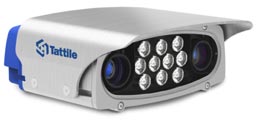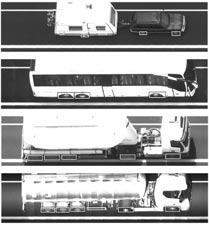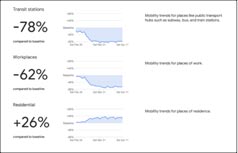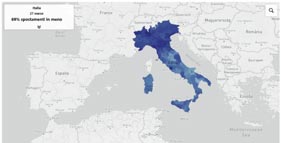N° 4
April 2020
—
TTS Italia is the Italian ITS Association founded with the aim to promote the development and deployment of Intelligent Transport Systems (ITS) in Italy. |
|
|
|
|
|
|
Transport, the rebus of phase two TTS Italia launches a survey to identify new mobility models
One of the biggest challenges of phase two of the Covid-19 emergency lies in transport: allowing the mobility of people and goods, respecting social distancing and anti-contagion health standards. It appears as a puzzle for the Government, the task force for the restart, the regional tables and the public administrations, all called to reorganize the connections in the cities, between urban centers and the hinterland in favor of commuters, in general throughout Italy (and in the long run also with foreign countries). A passage seems to gather all the reflections: a massive use of technology is needed, but what is the best solution or the mix of measures that can give the country a semblance of normality, protect the right to mobility and health?
To answer this question, TTS Italia launched a survey among its members, also involving municipalities, provinces and regions of the TTS Italia Local Authorities Platform as well as the ITS Associations in Europe and outside , aimed at gathering ideas, solutions and products to face the restart. "Our goal - explains Olga Landolfi, secretary general of TTS Italia - is to arrive at a series of concrete proposals to be submitted to political and technical decision-makers called to organize phase 2. We are collecting and elaborating all the proposals that are coming".
The questionnaire investigates, among other aspects, the impact of private mobility in the post-Covid scenario. Following what is happening in China, considered as the front-runner country in this situation, a massive return to private car use is expected. Suffice it to say that in China the use of private transport has gone from 33% to 66% in a few weeks, while the number of people getting on the buses is decreasing: from 56% to 24%, completely reversing the relationship between collective and private mobility, with inevitable impacts for congestion and environment. Also the task force wanted by the Government and led by Vittorio Colao, assumes the opening of the LTZ of Rome and the stop of area C of Milan.
The questionnaire prepared by TTS Italia aims to investigate the challenges the managers of collective public services will be facing on the possibilities of guaranteeing social distancing in the use of these services. Among the possible solutions, the smart working, but also arrivals at different times in the work and study places. However, so solution can be separated from a greater use of digital technology and processes. The survey also investigates on the role of service providers in support of collective transport, but also on the interconnection between logistics operators.
In short, the methods of moving people and goods will have to be rethought and new mobility models will be prepared. A process that calls into question the role of mobility managers, who will become central in the organization (including shifts) of big companies. Another interesting chapter - addressed in the TTS Italia survey - concerns the management of big data to support the reorganization of mobility in phase 2 (and in phase 3). Knowing as much as possible the dynamics of the movement of people and goods would allow to prepare models closer to the needs of the community.
The survey also questions the role of sharing mobility, a topic addressed in many contexts in the past few weeks. If on the one hand the sharing of vehicles seems hindered by the need for disinfestation, certainly the role of the two wheels will be predominant on this side and, in fact, large cities such as Rome are already thinking of emergency plans based on soft mobility: bicycles, scooters, on-call services.
Finally, goods: logistics, pillar of phase one of the emergency, in particular to guarantee food and health supplies, but also in home-delivery which shows growth rates that exceed 100%, has been included in the survey to investigate possible developments in phase two.
In general, on technologies to support the simplification and dematerialisation of freight transport companies and on the use of ITS in support of road transport and urban logistics. On this front, it is also worth mentioning the work TTS Italia is carrying out with the working group on logistics that has not stopped in the lockdown phase, defining a final document now under consultation for members and associations involved in the workng group.
The final document will contain practical indications on the efficiency of the logistics of goods in Italy and will be sent to the institutions, in particular to the Ministry of Infrastructure and Transport, in the coming weeks.
|
|
|
|
|
|
|
5T is a local government-owned company, specialised in the governance of intelligent and sustainable mobility. 5T designs, develops and operates Intelligent Transport Systems (ITS), with the aim to improve both individual and collective mobility. Its shareholders are the City of Torino, the Piemonte Region and the Metropolitan City of Torino.
Over the last years, 5T has matured a strong expertise in Mobility as a Service and is currently in charge to lead, on behalf of its shareholders, the strategic programmes to enable the MaaS ecosystem in Torino and Piemonte. The company also leads the MaaS Working Group, promoted by TTS Italia, involving around 50 participants, among members and stakeholders, with the goal to present a Position Paper on the “Guidelines for the development of MaaS in Italy”.
—
PROJECT IN THE SPOTLIGHT
 BIPforMaaS is the new strategic project, funded by Piemonte Region and led by 5T, aimed at creating the conditions for the full deployment of Mobility as a Service in the urban and metropolitan area of Torino and in the whole Piemonte Region, starting from the existing BIP smart ticketing system of public transport. BIPforMaaS is the new strategic project, funded by Piemonte Region and led by 5T, aimed at creating the conditions for the full deployment of Mobility as a Service in the urban and metropolitan area of Torino and in the whole Piemonte Region, starting from the existing BIP smart ticketing system of public transport.
BIPforMaaS wants to stimulate and facilitate the digital transformation of our mobility system, defining the framework of rules for the market uptake of MaaS, enabled by a Regional MaaS Platform.
 The project addresses all the topics related to MaaS development: regulatory frameworks, policies and role of public governance; business models and commercial agreements among the transport operators and the new providers of digital mobility services; technology platforms, data and standards. BIPforMaaS intends to involve all the relevant stakeholders in a collaborative pathway to share a common vision and create a Piemonte MaaS ecosystem. The project addresses all the topics related to MaaS development: regulatory frameworks, policies and role of public governance; business models and commercial agreements among the transport operators and the new providers of digital mobility services; technology platforms, data and standards. BIPforMaaS intends to involve all the relevant stakeholders in a collaborative pathway to share a common vision and create a Piemonte MaaS ecosystem.
Piemonte Region presents therefore itself, with the technical support of 5T, as the first Local Administration in Italy to lead a systemic MaaS project, with a clear vision on how mobility will change and how this huge change might be driven by public governance, in order to generate economic, environmental and social benefits.
More information available soon on the project website:
www.bipformaas.it
—
FOUR QUESTIONS TO
Matteo Antoniola, Business Strategy Manager at 5T
 What is Mobility as a Service (MaaS)? What is Mobility as a Service (MaaS)?
Mobility as a Service, generally known as MaaS, is a new concept of mobility that provides the integration of multiple transport services, both public and private, into one single digital mobility service, accessible via smartphone. The service is delivered by an integrated platform with many functionalities and a single payment system, and is able to provide personalised solutions to any specific mobility needs, therefore offering all the freedom of mobility that people want. All in one single app.
For the users, MaaS represents the possibility to easily access different and integrated transport services (public transport, bus, tram, metro, railway, taxi, car sharing, bike sharing, moto sharing, e-scooter sharing, on demand public transport, ride hailing, ride sharing, long haul bus, park&ride, car rental, etc.), using a single digital channel that suggests the best travel solution, according to the individual needs. MaaS services have to be complete, accurate and always available, and to offer integrated services, such as planning, booking and payment for any travel and any transport modes, during both working and weekend days, in order to meet any mobility needs and to be perceived by the users as an integrated mobility service as valuable as the private car.
We believe that, within this context of huge transformation, MaaS could strongly contribute to reach societal benefits. Benefits for the users, thanks to new and innovative services providing simple and immediate access to several transport services and meeting any mobility needs. Benefits for the market, whereas both digital economy and transport companies will be able to design and operate new services, giving their customers an agile, safe, secure, tailored and digital “mobility experience”. Benefits for the Public Administration, that will have the chance to turn MaaS platforms into powerful tools for promoting citizens’ modal shift towards more sustainable modes and then for reaching environmental, social and economic goals like never before!
Can you tell us more about the BIPforMaaS project?
BIPforMaaS is the new strategic project, funded by Piemonte Region and led by 5T, aimed at creating the conditions for the full deployment of Mobility as a Service in the urban and metropolitan area of Torino and in the whole Piemonte Region, starting from the existing BIP smart ticketing system of public transport.
BIPforMaaS will foster the digital transformation of our mobility system and will define the framework of rules for the upcoming market of MaaS services, enabled by a Regional MaaS Platform.
The project has started in autumn last year and has a 30-months horizon, with the aim of establishing a fully functional MaaS ecosystem for Piemonte Region by 2022.
We at 5T, together with Piemont Region, are convinced that digital transformation in mobility will be at the center of the digital innovation agenda for the whole country. For this reason, within the project, we will also pay strong attention to disseminate knowledge in the filed of MaaS, in order to stimulate a national debate on the future of mobility and on the role of public governance. I therefore invite all those interested in learning more about MaaS to follow us in this journey, visiting the project website www.bipformaas.it/eng, soon online!
What about the future of mobility and MaaS?
A few years ago, we would have never imagined that with a simple click, comfortably sitting on the sofa or during a trip, we would have had the opportunity to access an incredible range of movies and TV series. Then digital platforms like Netflix, Prime Video or Infinity came up and in a very short time they changed completely our habits and revolutionised our relationship with the television. The same digital transformation happened with music, with platforms, like Spotify, Amazon Music or iTunes. Nowadays everything is becoming increasingly available “whenever you want” and “wherever you want”, in order to meet rapidly changing needs and habits of customers, who are more and more digitised.
In this digital scenario, also mobility has the chance to strongly innovate, offering “on demand” services tahnks to the new concept of Mobility as a Service. It will still take some time to see a large scale diffusion of MaaS services, but the road forward is marked out and the journey has already begun. MaaS will change the way we move, and more. As it was the case for moovies and music, also mobility will become soon an “on demand” service, following a paradigm that we at 5T have called MooD (Mobility on Demand).
Will the recent Covid-19 emergency change the role of Mobility as a Service?
Certainly, at least in part.
We have clearly understood that Mobility as a Service is going to be a new digital matching between mobility demand and transport service offer.
I am one of those MaaS Lovers, who are trying since long time to imagine and shape a future, where Mobility as a Service might help all of us moving easily around, while at the same time paying attention to sustainability. But nowadays any human being on Earth, including me and you, are going through and experience that will probably change our lifestyle for the years to come. We will all have to reconsider not only how and why we move, but how we work/study and more generally how we live.
Some of our past mobility needs won’t be perceived as necessary anymore, while some of them will be replaced much faster than expected by “virtual mobility”. We will probably face a trade-off between physical transport journeys and virtual internet-based activities. This will lead to less mobility demand on the whole, that will naturally cause a revolution in the transport service industry, affecting quantity and quality of service, but also the underlying business models.
In this upcoming mobility disruption, a new equilibrium will be reached, in order to meet mobility demand and transport offer in a post-pandemic, fully digitised and highly virtualised mobilty era. People will change significantly habits and mobility behaviours, as well as their prioritires and selection criteria; policies will change, regulating who, when, why and how can and/or must move within a mobility community; therefore transport offer will change, modelling itself and adapting to match a completely new demand.
On top of this new equilibrium, I am convinced that MaaS might still play a key role. Taking into account new keywords, such as health, safety and flexibility. That should be considered as valuable as the already well-known ones, such as personalisation, digitalisation, integration and sustainability.
|
|
|
|
|
|
|
Smart Proximity: the Engineering integrated platform for working safely
 In the post-quarantine days, when the Covid-19 infection will be contained but we will not yet have a vaccine capable of immunizing us, the first rule to protect our health will always be to keep the safety distances. In the post-quarantine days, when the Covid-19 infection will be contained but we will not yet have a vaccine capable of immunizing us, the first rule to protect our health will always be to keep the safety distances.
How can a company go back to carrying out its activities by protecting employee health? What technological solutions will help to ensure safety in the workplace?
Engineering, TTS Italia ordianry member, has developed an ad hoc solution to manage the recovery of work in total safety in the post-Covid-19.
Smart Proximity is an integrated platform that analyzes, monitors and predicts risk behavior of personnel in the workplace. It intervenes in real time with warning messages addressed to operators who exceed the appropriate safety distances.

Each operator is equipped with a wearable proximity sensor (Proximity Sensor), for example a bracelet, which relates to one or more sensors nearby by sending and receiving information.
The generated data is sent to a server, which creates a graph of relationships and monitors in real time the respect of the distances between the staff (Proximity Monitor).
When two sensors record the exceeding of the safety distance in a specific time interval between two operators, it signals to them (Proximity Messaging) the criticality with vibration, LED or sound.
Data analysis (Proximity Analytics) allows you to intervene preventively and proactively to ensure the safety of all operators.
The benefits are manifold:
Real-time monitoring of safety distances between operators;
Identification of risk behaviors and possible relationship clusters;
Behavioral analysis to guarantee safety standards;
Alert to report critical behavior to the employee;
Guarantee of the protection of the privacy of the individual.
Smart Proximity can be adopted in various work areas: in offices, at airports, in the logistics and shipbuilding sectors, for example and in every context, the following are guaranteed:
Storage with historical data on proximity relations;
Reliability and availability of data on distributed architecture;
Monitoring dashboard to identify critical behavior in real time and report anomalies;
Integration with external systems with standard communication protocols;
Security, verification and validity of the data collected.
For further details an dinformation on the technology adopted, click here
|
Tattile Axle Counter automates key information on number of axes
 Many toll systems around the globe have made the number of axes of a vehicle a key parameter for determining the toll. According to this information different tariffs apply for the respective vehicle. Even if the vehicle volume is taken into account the volume itself does not identify univocally a vehicle class since two vehicles could have the same volume but a different number of axes. Therefore having the information on the number of axes of a vehicle is crucial. Many toll systems around the globe have made the number of axes of a vehicle a key parameter for determining the toll. According to this information different tariffs apply for the respective vehicle. Even if the vehicle volume is taken into account the volume itself does not identify univocally a vehicle class since two vehicles could have the same volume but a different number of axes. Therefore having the information on the number of axes of a vehicle is crucial.
Tattile in its endeavor to simplify and continuously rise accuracy of Intelligent Traffic Systems now addresses this gap and introduces its automatic axle counting system “Axle Counter”. The Tattile Axle Counter automatically counts the axles of any vehicle driving at a speed up to 180 km/h on a highway. The entire system ensures correct axle counting and is mounted on a gantry above the highway. The installation is on a gantry and the stand-alone system is capable of analyzing the side of the passing vehicle with its internal processing algorithms. 
The Axle Counter operates completely automatically meaning that no post-processing of the pictures taken is necessary anymore, nor is there any more need for visual inspection and interpretation of the pictures by humans. Its high detection rate and high accuracy allow precise counting of the axles of any particular vehicle. The system includes two cameras per lane to ensure left sight and right sight. An IR illuminator allows operating both day and night. All image analysis operations including the use of AI to automatically recognize the axle and wheel as well as counting are done on-board of the system in real-time.
With the new Axle Counter Tattile fills the missing link of providing all relevant vehicle information automatically to determine the correct toll for a given vehicle.
For any further information: Costantino Volpe, PROJECT MANAGER - TRAFFIC DIVISION - c.volpe@tattile.com and visit www.tattile.com/
|
COP City Operations Platform - the VIASAT platform for URBAN SECURITY
 COP - City Operations Platform is Viasat’s URBAN SECURITY platform, a unique intelligent system for managing the security of the territory, sensors, devices, and people. COP provides the company and Public Administrations with a platform made up of several verticals available in Security, Mobility, and Field Management segments. COP - City Operations Platform is Viasat’s URBAN SECURITY platform, a unique intelligent system for managing the security of the territory, sensors, devices, and people. COP provides the company and Public Administrations with a platform made up of several verticals available in Security, Mobility, and Field Management segments.
To keep up with citizens' expectations and meet new and increasingly demanding needs, Public Administrations require innovative systems to exploit and integrate data, improve processes and make proactive, and real-time decisions. In this new paradigm, which rests on the pillars of participation, collaboration, sharing, sustainability, and social and technological innovation, a service platform for secure cooperation (Security As A Service) assumes even more importance.
A unique and future-oriented experience of mobility that has made Viasat the ideal partner also for those municipalities that want to implement innovative Smart City systems, through urban mobility services, street monitoring, smart parking, air quality detection, platforms integrated land management and many other flexible solutions designed to meet the needs of any type of public administration.
 Especially, Street Control is the main tool and reference point for road safety on the Italian territory. Street Control allows the Police Officers to automatically read and check license plates of moving or stationary vehicles and to check, according to the available databases, administrative defaults (Insurance, Revisions), stolen vehicles and much more. Especially, Street Control is the main tool and reference point for road safety on the Italian territory. Street Control allows the Police Officers to automatically read and check license plates of moving or stationary vehicles and to check, according to the available databases, administrative defaults (Insurance, Revisions), stolen vehicles and much more.
Street Parking is an evolution of the previous one to allow municipalities to manage to park ruled and mobility in a smart city perspective. It is an innovative and patented system (Cloud platform) that allows for solving the physiological problems of managing and using on-street parking. The wide possibility of Street Parking data processing enables accurate analysis relating to occupation and payment, allowing targeted corrective and/or development activities and actions.
Finally, Street Truck allows the Police to download, read and check wirelessly the data of the tachograph and, with the help of the Tablet and PC, have an immediate and legible report of all infringements of the Road Rules, facilitating and automating the compilation of the minutes.
For more information: www.viasatonline.it - www.streetcontrol.it
|
|
|
|
|
|
|
Covid-19: effects on the transport system
The Transport, Mobility, Infrastructure and Systems Commission of the Order of Engineers of the Province of Turin and of the Polytechnic of Turin (Delegated Transport Group), TTS Italia ordinary member, has drawn up the orientation document "Considerations and actions on the effects COVID-19 on the transport system ".
The purpose of the text is to highlight what the repercussions on the transport system may be due to the COVID-19 epidemic and to propose actions aimed at solving the problems encountered or feared.
The document is intended as a technical contribution to the territory, without specific political, administrative or corporate influences.
The text does not examine the issue of the costs of the proposed or assessed measures - even if they are sometimes pointed out - because it is outside the technical-engineering mandate.
For the document, click here (available in Italian)
Source: POLITO |
Car fleets: thefts plummeted 85% in March
In the second half of March, in particular from the day following the Prime Minister's Decree of 16 March "Cura Italia", car thefts across Italy decreased by 85% compared to the weekly average. The figure refers to the cars that are part of company and short-term rental fleets and is an extremely significant figure, given the very high average number of thefts in periods of normalcy especially in some highly concentrated Italian areas, still a problem for some industrial sectors such as the rental sector, which typically use recently registered cars. Targa Telematics, a company specialized in technological solutions for mobility and TTS Italia founding member, elaborates them, providing some of the main operators in the car rental market with digital platforms for vehicle monitoring. Overall, Targa Telematics monitors more than 450 thousand assets belonging to the sectors mentioned above.
The decrease in thefts is generalized in all Italian regions and in the weeks preceding that of March 16, the trend of these crimes had recorded only a slight decrease.
Source: Targa Telematics |
Geotab: every week a new webinar. On 29 April “Crash: how to recognize and analyze a possible accident"
Geotab, TTS Italia ordinary member, organizes a webinar every week on specific topics.
Wednesday, April 29, in the webinar "Crash: how to recognize and analyze a possible accident" at 15.00 (lasting one hour), it will be discussed how it is possible to recognize and analyze a possible road accident with the support of the features and data available on the MyGeotab platform.
More in detail, the following will be described:
- Operation of the OBD GO9 device and the integrated accelerometer
- Crash notification and analysis features on the MyGeotab Platform
- False positives and real crashes
Speaker: Davide Pignalosa
Moderator: Fabio Pierantozzi
To participate, click here
Source: Geotab |
Here and Enel X together for an emergency mobility map
HERE Technologies, global leader in geographic data and mapping services and TTS Italia ordinary member, and Enel X, the innovative global business line of the Enel Group, have launched, in support of the Covid-19 emergency, "City Analytics", a 'Mobility Map' which estimates the variation in movements and kilometers traveled by citizens on the national, regional, provincial and municipal territory. The service provides a mapping of macro mobility flows, based on the analysis of anonymized and aggregated data from connected vehicles, maps and navigation systems, processed in correlation with location data from mobile and open data applications of the Public Administration.
The processing of the data, explains a note, results in the identification of some key indicators such as the daily percentage change, compared to January 2020 average, of the number of trips in the area, with an aggregated regional, provincial and municipal view o the daily percentage view with evidence of the areas crossed at the entrance and exit of each Municipality, Province, Region.
The data can be consulted free of charge until May 31, 2020 by the central and local Public Administrations, by the interested bodies and by the Civil Protection, on the Enel X YoUrban portal, and used to understand the impacts of the containment measures of COVID-19; identify the areas that need more support in the implementation of these measures; analyze the gradual return to normal in a data driven way, once the pandemic is over.
Source: Ansa |
Mobility DataLab: daily data on mobility flows
Octo Telematics, TTS Italia ordinary member, and Infoblu come together to provide useful and updated data on vehicle mobility in Italy. The two companies have in fact created a site, Mobility DataLab, with graphics and detailed information updated daily on the use of light and heavy vehicles available to administrations, the media and the public. The goal is to be able to communicate and make available reliable data on mobility flows, fundamental tool in this moment of extreme emergency.
The site launched on April 14 (lab.octotelematics.com), is articulated through a standard set of graphs relating to the trend of mobility in Italy in this period. The data will describe the trend of mobility in relation to a standard reference period, on a daily and geographical basis compared with the average reference period. This will allow to have a careful, intelligent and dynamic look at urban and suburban mobility. The information will be updated at 01.00 in the morning. The information is collected in completely anonymous form by the Octo Telematics devices installed on cars and heavy vehicles.
The two companies contributed with their respective skills on flow analysis and key indicators, with the participation of technicians, mathematicians and big data experts. The experts are also working on a smartphone application that will allow you to complete the self-certification on travel in digital format, thus facilitating citizens' compilation and law enforcement, through a unique code, faster verification.
Source: Octo Telematics |
Mobility in Turin and Piemonte region during the COVID-19 emergency. The study of 5T
On behalf of the Piemonte Region and the City of Turin, 5T, TTS Italia ordinary member, carried out a study on the trend of Turin and Piemonte mobility from 3 February to 29 March 2020 with the aim of monitoring the trend of mobility in cities and throughout the region during the Covid-19 emergency.
Thanks to the data collected and processed by the Mobility Center, managed by 5T on behalf of the two entities, it was possible to outline a first general framework that confirms the impact of the restrictive measures on the limitation of travel.
Compared to the period prior to the beginning of the emergency (period between 3 and 23 February 2020), traffic in Piemonte decreased by 62% on weekdays and by 89% on holidays. Internal travel between the 8 Piedmont provinces has also decreased, recording significant reductions of 70-80% in recent weeks. The movements originating from Lombardy towards Piemonte are reduced, but not in a decisive way: -50%.
As for Turin, city traffic decreased by 60% during weekdays and by 72% during the weekend. Movements from other Italian provinces to Turin also decreased with 85% reductions on weekdays and 95% on weekends.
Transits within the Central LTZ also decreased (-61% on weekdays and -76% on holidays) while the occupation of the 34 parking lots located in the city stands on more limited reductions: -44% on weekdays and -35% on holidays.
As for public transport, the analysis focused on the number of daily validations at the Turin metro line 1, with significant reductions of 86% on weekdays and -91% on weekends.
The use of the private bicycle also decreases. Thanks to the sensors of the Handshake project of the City of Turin, the cycling flows on the specific cycle axes were analyzed. Bicycle travel is reduced by 67% during the week and 73% on holidays, also in consideration of the closure of the university poles which are located along some cycle paths taken into consideration.
Monitoring of the situation will continue in the coming days.
Source: 5T |
Targa Telematics launches Targa Lite, to reduce waste in corporate fleet management
Targa Telematics, TTS Italia founding member, has made available on the market a new solution to identify and reduce the waste of corporate fleets in respect of privacy: Targa Lite.
Through telematics, Targa Lite allows companies and in particular fleet managers to highlight the costs that are not usually accounted and the waste associated with the use of the fleet, to manage fuel supplies efficiently and to optimize the costs related to the maintenance of the fleet itself. All without geolocation and therefore respecting the privacy of individual drivers.
With regard to wastes, Targa Lite aims to reduce two in particular: the first, linked to the use of company vehicles which allows fleet managers to quantify the kilometers traveled for non-work or non-professional purposes, so as to be able to attribute to the driver the correct rate provided by company policies; the second, relating to the expense of purchasing fuel, monitoring the extra costs incurred by the company for refueling without paying due attention to the price of fuel per liter.
In concrete terms, the advantage of introducing Targa Lite into its fleet is evident from the first two months of use: it has in fact been calculated that thanks to the solution, a company can reduce waste by up to 20%, in addition to having the tools to concretely evaluate the economic return on investment.
The operation of Targa Lite is very simple, as is its implementation: it is sufficient to install an IoT device on the fleet's vehicles and enter the reference parameters in the web platform to offer the fleet manager tailor-made monitoring. From a technological point of view, Targa Lite uses Internet of Things devices and the Mobility Digital Platform, the digital platform of Targa Telematics that massively uses artificial intelligence and machine learning based on big data analysis, integrating the information collected by the customer fleet with the know-how acquired over the years by the company.
The information required by the platform is linked to the working calendar, the fuel card and the tolerance threshold that each fleet manager sets with respect to the use of fuel. Once these data have been entered, the fleet manager can set the objectives and monitor their achievement. In addition, corrective measures to the entire fleet, portions of it or to specific groups can be applied.
Targa Lite also offers the possibility of implementing and tracking proactive awareness actions regarding the issue of waste. Targa Lite is a solution suitable for corporate fleets of any size.
osì come previsto dalla policy aziendale – e di ottenere un importante ritorno sugli investimenti.
Source: Targa Telematics |
Transport and innovation: a survey on the women’s role
The SUITS project, including among members Roma Servizi per la Mobilità and Politecnico di Torino, TTS Italia ordinary members, launched a survey dedicated to the role and contribution of women in research related to transport innovation and smart mobility.
The SUITS project is a four-year research and innovation action, with the aim of increasing the capacity building of local authorities and transport actors and of transferring learning to smaller cities, guiding them towards sustainable transport. SUITS is one of the three projects of the EU CIVITAS 2020 initiative focused on sustainable urban mobility plans.
The survey takes about 40 minuti.
For participating, click here
Source: SUITS Project |
Velocar wins tender for the control of traffic light infringements
Velocar, TTS Italia ordinary member, has been awarded the tender launched by the Municipality of Grugliasco for the supply and rental service of an approved system for the automatic detection of traffic light infringements composed of 11 equipments. The tender is also including management and maintenance for the duration of 36 months.
Source: TTS Italia
|
Viasat: trucks thefts almost halved in Italy
In 2019, the thefts of heavy vehicles in Italy were 1,429 against over 3,000 in 2018, with a reduction of 42.3% on the annual figure. On the discovery front, we remain more or less on the same levels as the previous year. How to defend yourself? With technology. These are the main results from the forthcoming Viasat Group Autotrasport 2020 Dossier.
THE RESEARCH: ALL ITALIAN REGIONS RECORD DOWN PERCENTAGES - According to the statistics prepared by the Traffic Police, almost 119 trucks thefts are registered in our country per month (283 in 2018), 4 per day. Puglia continues to be the most at risk region in Italy with 260 thefts per year. Lombardy (246) and Campania (204) follow. Gradually all the others: Sicily (131), Lazio (125), Emilia Romagna (95). However, there is no region that does not register a substantial decrease compared to the previous year.
Only 47% of heavy goods vehicles are recovered, not even half of those stolen, even if this is a slightly better figure than that of 2018 (40%). In short, too often there is no trace of consumer electronics products such as TVs, tablets, smartphones, computers, appliances, together with tires, drugs, cigarettes, as well as clothing and food products, causing enormous economic damage for transport and logistics.
HOW TO COUNTER THE PHENOMENON: THE DOMINANT ROLE OF SATELLITE TECHNOLOGY - “Technology - explains Domenico Petrone, President of Viasat Group, TTS Italia ordinary member - certainly constitutes a deterrent of valid support to the widespread control of the territory and to the investigation activity taking into account that approximately 40% of the arrests are carried out in the act of a crime. It is estimated that, at the end of 2021, one in three vehicles in circulation will be made active from a satellite telematic point of view. In short, Cargo Crime is answered with useful innovation to track and locate vehicles and goods in real time."
Today's cutting-edge solutions allow you to generate automatic alarms useful for the Fleet Manager to detect unauthorized movement of the vehicle, the unauthorized opening of a tailgate or the release of a trailer. In Viasat there are 40 automatic alarms managed by the H24 Operations Center which also allow, in case of lack of identification of the driver, to inhibit the starting of the vehicle and to intervene the police in case of robbery or danger. "The statistics - continues Domenico Petrone - attest to the effectiveness of the satellite and IoT technologies proposed by Viasat, recording, compared to the national numbers, fewer thefts and a significantly higher percentage of vehicles found.
Furthermore, the Viasat high security functions represent an effective contrast to the robberies of the means of transport carried out with the help of jammer (frequency jammer), thanks to the assistance of specialized operators who can monitor the most delicate transports, in real time, promptly detecting potential anomalous events.
Source: Viasat
|
|
|
|
|
|
|
Technology vs Covid: TTS Italia on IRF Global
Coronavirus will be the litmus test for digital, innovation and technology in Italy. This unexpected and extremely difficult situation for the whole world has affected an Italy that within a few days had to draw on a series of skills that have put institutions, businesses and individual citizens in front of the possibilities offered by the technological leap.
TTS Italia Secretary General, Olga Landolfi, wrote about that for IRF Global
Read the article here |
Impact of the Covid-19 epidemic on global mobility
The following article is by Elena Viaciago, The Innovation Group, organizer of the “Smart&Connected Mobility Summit”to be held in July in Milan and including TTS Italia among sponsors.
 Since the outbreak of the Covid-19 epidemic, there has been a revolution in the way people communicate and collaborate. With the population isolated in their homes, but active from a working point of view through Smart Working, the roads have been replaced by networks, and traffic, which in the cities and main arteries that connect the country has collapsed, has become “digital traffic”, making a leap: more 60% on fixed networks, + 30% on mobile networks. All over the world, the mobility sector has experienced an epoch-making reversal, with a collapse in travel, as it has been seen for example by Google, with its “Mobility Reports” for each individual country. It is interesting to note that in Italy, between the end of February and 11 April, according to Google's location data, public transport places (bus stops, train stations, subways) had seen a reduction in traffic equal to - 78%, places of work had experienced a 62% reduction in access for people, public spaces such as parks had recorded a - 83%, restaurants, shopping centers had achieved a - 86%, but around individual places of residence, the movements have instead increased by 26%. Since the outbreak of the Covid-19 epidemic, there has been a revolution in the way people communicate and collaborate. With the population isolated in their homes, but active from a working point of view through Smart Working, the roads have been replaced by networks, and traffic, which in the cities and main arteries that connect the country has collapsed, has become “digital traffic”, making a leap: more 60% on fixed networks, + 30% on mobile networks. All over the world, the mobility sector has experienced an epoch-making reversal, with a collapse in travel, as it has been seen for example by Google, with its “Mobility Reports” for each individual country. It is interesting to note that in Italy, between the end of February and 11 April, according to Google's location data, public transport places (bus stops, train stations, subways) had seen a reduction in traffic equal to - 78%, places of work had experienced a 62% reduction in access for people, public spaces such as parks had recorded a - 83%, restaurants, shopping centers had achieved a - 86%, but around individual places of residence, the movements have instead increased by 26%.
 On the roads of the Peninsula between 23 February and 25 March, travel was reduced by 69%. The interactive view of the map reported by Repubblica newspaper, based on data from Teralytics (a company in Zurich specialized in providing indicators on the mobility of people) has shown how gradually some regions turned blue: “We used the data of the SIM cards of 27 million people. Anonymous data, of course” explained Teralytics co-founder Georg Polzer. On the roads of the Peninsula between 23 February and 25 March, travel was reduced by 69%. The interactive view of the map reported by Repubblica newspaper, based on data from Teralytics (a company in Zurich specialized in providing indicators on the mobility of people) has shown how gradually some regions turned blue: “We used the data of the SIM cards of 27 million people. Anonymous data, of course” explained Teralytics co-founder Georg Polzer.
In the coming months, with the start of Phase 2 of reopening of activities, personal travel will start to grow again (even if initially still with limitations and closings, for example between the various Regions), and the world of transport will be heavily involved as it enables this recovery phase. In fact, although many people will continue to work in smart working, and others will probably prefer the use of private transport, for many, public transport will be essential to reach the workplace. Therefore, the implementation of an overall design for the transport system is essential, to ensure distances between people, enable greater controls (termoscanner, use of masks) and provide disinfection measures for vehicles. Only in this way will we have the scientific certainty of keeping the infection under control, identifying continuously who is healthy and who is not, reducing the chances for the spread of the virus, thanks to the right tools to monitor and manage the situation. |
|
|
|
|
|
|
• Italia-Napoli
Services for parking areas management
• Italia-Padova
Services for parking areas management
|
• Italia-Roma
IT services
• Italia-Roma
Videosurveillance system
|
|
|
|
|
|
|
|
|
|
|
|
|
|
|
|